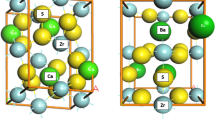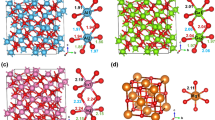Abstract
This study examines the electron localization function (ELF) isosurfaces of the Al2SiO5 polymorphs kyanite, sillimanite, and andalusite to see how differences in coordination and geometry of the cations and anions affect the ELF isosurfaces. Examination of the ELF isosurfaces indicates that their shapes are dependent on the coordination and geometry of the oxygen atoms and are not sensitive to coordination of the surrounding cations. Of the 18 crystallographically distinct oxygen atoms in the Al2SiO5 polymorphs, 13 are bonded to two aluminum atoms and one silicon atom (Al2–O–Si) and are associated with two different ELF isosurface shapes. The shape of the ELF isosurface is dependent on the distance at which the oxygen atom lies from a plane defined by the three surrounding cations: at a distance greater than 0.2 Å the ELF can be defined as horseshoe-shaped and at a distance less then 0.2 Å it can be described as concave hemispherical. This feature is also seen in the ELF isosurfaces for the oxygens bonded to three aluminum atoms (Al3–O) where the isosurfaces can be defined as trigonally toroidal and uniaxially trigonally toroidal. The changes in the ELF isosurfaces for the three coordinated oxygens are also indicative of changes in hybridization. The ELF isosurface for the two-fold coordinated oxygen (Al–O–Si) has a large mushroom-shaped isosurface along the Al–O bond and a concave hemispherical isosurface along the Si–O. The four-fold coordinated oxygen (Al4–O) contains two concave hemispherical isosurfaces along the shorter Al–O bonds and a banana-shaped isosurface, which encompasses the longer Al–O bonds. In addition, this study shows the homeomorphic relationship between the ELF isosurfaces and electron density difference maps with respect to number and arrangement of domains.





Similar content being viewed by others
References
Bader RFW, Johnson S, Tang TH, Popelier PLA (1996) The electron pair. J Phys Chem 100:15398–15415
Becke AD, Edgecombe KE (1990) A simple measure of electron localization in atomic and molecular systems. J Chem Phys 92:5397–5403
Bell DR, Rossman GR (1992) Water in earth’s mantle: the role of nominally anhydrous minerals. Science 255:1391–1397
Burdett JK, McCormick TA (1998) Electron localization in molecules and solids: the meaning of ELF. J Phys Chem A 102:6366–6372
Chesnut DB (2000) An electron localization function study of the lone pair. J Phys Chem A 104:11644–11650
Dahaoui S, Hansen NK, Protas J, Krane H-G, Fischer K, Marnier G (1999) Electric properties of KTiOPO4 and NaTiOPO4 from temperature-dependent X-ray diffraction. J Appl Crystallogr 32:1–10
Gillespie RJ (1970) The valence-shell electron pair model of molecular geometry. J Chem Educ 47:18–23
Gibbs GV, Cox DF, Boisen MB, Downs RT, Ross NL (2003) The electron localization function: a tool for locating favorable proton docking sites in the silica polymorphs. Phys Chem Min 30:305–316
Gibbs GV, Cox DF, Ross NL, Crawford TD, Burt JB, Rosso KM (2005) A mapping of the electron localization function for earth materials. Phys Chem Min 32:208–221
Hohenberg P, Kohn W (1964) Inhomogenous electron gas. Phys Rev B 136:864–871
Kirfel A, Lippmann T, Blaha P, Schwarz K, Cox DF, Rosso KM, Gibbs GV (2005) Electron density distribution and bond critical point properties for forsterite, Mg2SiO4, determined with high energy synchrotron radiation: a comparison of experimental and theoretical properties for earth materials. Phys Chem Min 32:301–313
Kresse G, Furthmuller J (1996) Efficiency of ab-initio total energy calculations for metals and semiconductors using a plane-wave basis set. Comp Mater Sci 6:15–50
Kresse G, Hafner J (1993) Ab initio molecular dynamics for liquid metals. Phys Rev B 47:558–561
Lewis GN (1966) Valence and the structure of atoms and molecules. Dover Press, New York
Monkhorst HJ, Pack JD (1976) Special points for Brillouin zone integrations. Phys Rev B 3:5188–5192
Muscenti TM, Gibbs GV, Cox DF (2005) A simple chemical view of relaxations at stoichiometric (110) surfaces of rutile structure-type oxides: a first-principles study of stishovite, SiO2. Surf Sci 594:70–82
Savin A, Nesper R, Wengert S, Fässler TF (1997) ELF: The electron localization function. Angew Chem Int Ed Engl 36:1808–1832
Savin A, Becke AD, Flad J, Nesper R, Preuss H, von Scnering HG (1991) A new look at electron localization. Angew Chem Int Ed Engl 30:409–412
Silvi B, Savin A (1994) Chemical bonds in minerals: topological analysis of the electron localization function. Min Mag 58A:842–843
Terriberry TB, Cox DF, Bowman DA (2002) A tool for the interactive 3D visualization of electronic structure in molecules and solids. Comput Chem 26:313–319
Vanderbilt D (1990) Soft self-consistent psuedopotentials in a generalized eigenvalue formalism. Phys Rev B 41:7892–7895
Winter JK, Ghose S (1979) Thermal expansion and high-temperature crystal chemistry of the Al2SiO5 polymorphs. Am Min 64:53–586
Acknowledgments
This study was supported by the National Computational Science Alliance under a SURA Block Grant (Project ndg), utilizing the IBM p690 at the National Center for Supercomputing Applications and by the National Science Foundation (Grant EAR-0229472 to NLR and GVG).
Author information
Authors and Affiliations
Corresponding author
Rights and permissions
About this article
Cite this article
Burt, J.B., Gibbs, G.V., Cox, D.F. et al. ELF isosurface maps for the Al2SiO5 polymorphs. Phys Chem Minerals 33, 138–144 (2006). https://doi.org/10.1007/s00269-006-0062-5
Received:
Accepted:
Published:
Issue Date:
DOI: https://doi.org/10.1007/s00269-006-0062-5




